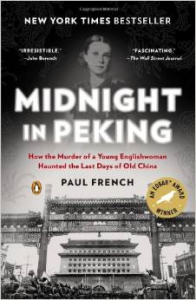 Why should anyone today care about solving an expat murder in 1937 Peking? We here at WoWasis were skeptical too. But we took a chance on Paul French’s Midnight in Peking: How the Murder of a Young Englishwoman Haunted the Last Days of Old China (2012, ISBN 978-0-14-312100-8) and were richly rewarded. It’s more than a murder story, as it tells much about how justice was bought and sold in the British Legation of pre-WW II Peking.
Why should anyone today care about solving an expat murder in 1937 Peking? We here at WoWasis were skeptical too. But we took a chance on Paul French’s Midnight in Peking: How the Murder of a Young Englishwoman Haunted the Last Days of Old China (2012, ISBN 978-0-14-312100-8) and were richly rewarded. It’s more than a murder story, as it tells much about how justice was bought and sold in the British Legation of pre-WW II Peking.
Pamela Werner was the free-spirited daughter of British scholar E.T.C. Werner. In 1937 she went missing one evening, and her body was found the next day, eviscerated. Her sternum was smashed, heart torn out, and genitalia mutilated. A nasty piece of work. The “usual suspects” were rounded up and a crack British investigator was called in from the city of Tientsin. Even Pamela’s father was, for a time, under suspicion. As the Japanese took over Peking, the case was shelved and forgotten. No one was ever brought to justice.
Historian and Sinophile Paul French, however, was intrigued enough about the case to reopen it more than half a century later. He combed through libraries, found old letters and testimonies, and in the book, reveals what contemporary investigators could not. She was murdered by a member of Peking’s upper class business establishment. Interestingly, Pamela’s father took on the burden of investigating her death after the official case was closed, and French makes liberal use of his notes. By the time the book was written, virtually all the players had died. As French discovered, you basically bought your justice in Peking and high-level Brits were, to a large extent, untouchable. Sex parties involving these people were a fact of life in 1937 Peking, and it can be surmised from the book that sado-masochistic behavior was considered best hidden, even when it involved the murder of one of their own.
Readers may very well wonder why the author bothered. Pamela had been dead for decades and those responsible were no longer living. It’s French’s strong sense of justice that drives the book. There are two crimes that compelled the author to write the book, it seems. The first, of course, is that of her murder. The second, and perhaps the one that drove the author to spend so much time investigating the story and writing this book, is the crime that this young, vibrant woman had been forgotten. It’s to her, in fact, that he dedicates the book.
The book is highly recommended for those wishing to understand more about the British community in pre-war China and how criminal investigations can be so horribly obfuscated by bureaucracy and a desire to shield high-level people from incarceration. It’s a damn good true crime story. Buy this book now at the WoWasis eStore.


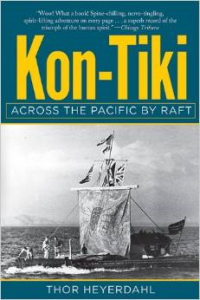


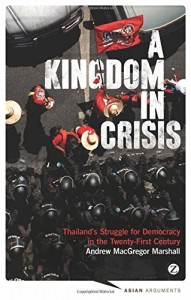


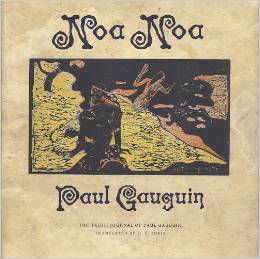 Noa Noa, painter Paul Gauguin’s short book on his time in Tahiti, often gets ignored today. Gauguin, after all, has been chastised for “cutting and running,” leaving a family behind there. Gauguin, who died in 1903, isn’t alive to rebut anything, of course. But he does leave the reader with his sometimes whimsical and at times poignant account of the several years he spent there. And then, of course, there’s his art.
Noa Noa, painter Paul Gauguin’s short book on his time in Tahiti, often gets ignored today. Gauguin, after all, has been chastised for “cutting and running,” leaving a family behind there. Gauguin, who died in 1903, isn’t alive to rebut anything, of course. But he does leave the reader with his sometimes whimsical and at times poignant account of the several years he spent there. And then, of course, there’s his art. From the ever-controversial
From the ever-controversial 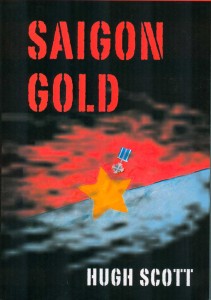
 Crusoe, of course, was a fictional character created by Daniel Defoe, who published his book in 1719. But his story was partly inspired by the true story of a man who was marooned on an uninhabited island. Diana Souhami’s Selkirk’s Island: The True and Strange Adventures of the Real Robinson Crusoe (2001, ISBN 0-15-100526-5) tells the remarkable story.
Crusoe, of course, was a fictional character created by Daniel Defoe, who published his book in 1719. But his story was partly inspired by the true story of a man who was marooned on an uninhabited island. Diana Souhami’s Selkirk’s Island: The True and Strange Adventures of the Real Robinson Crusoe (2001, ISBN 0-15-100526-5) tells the remarkable story.